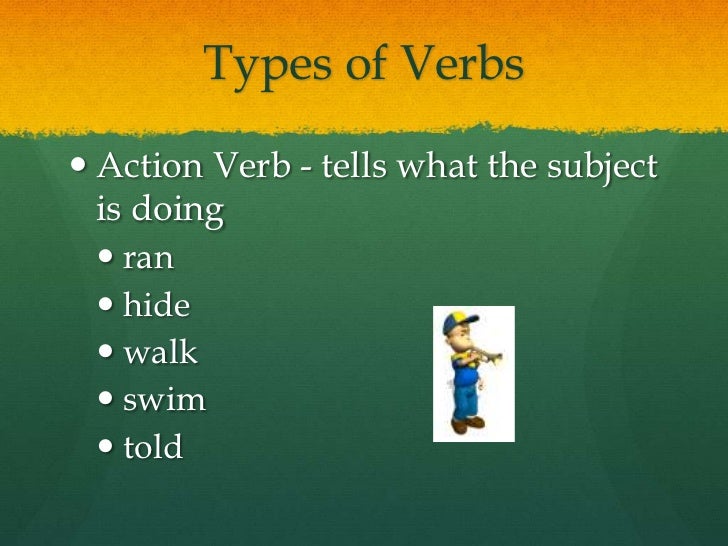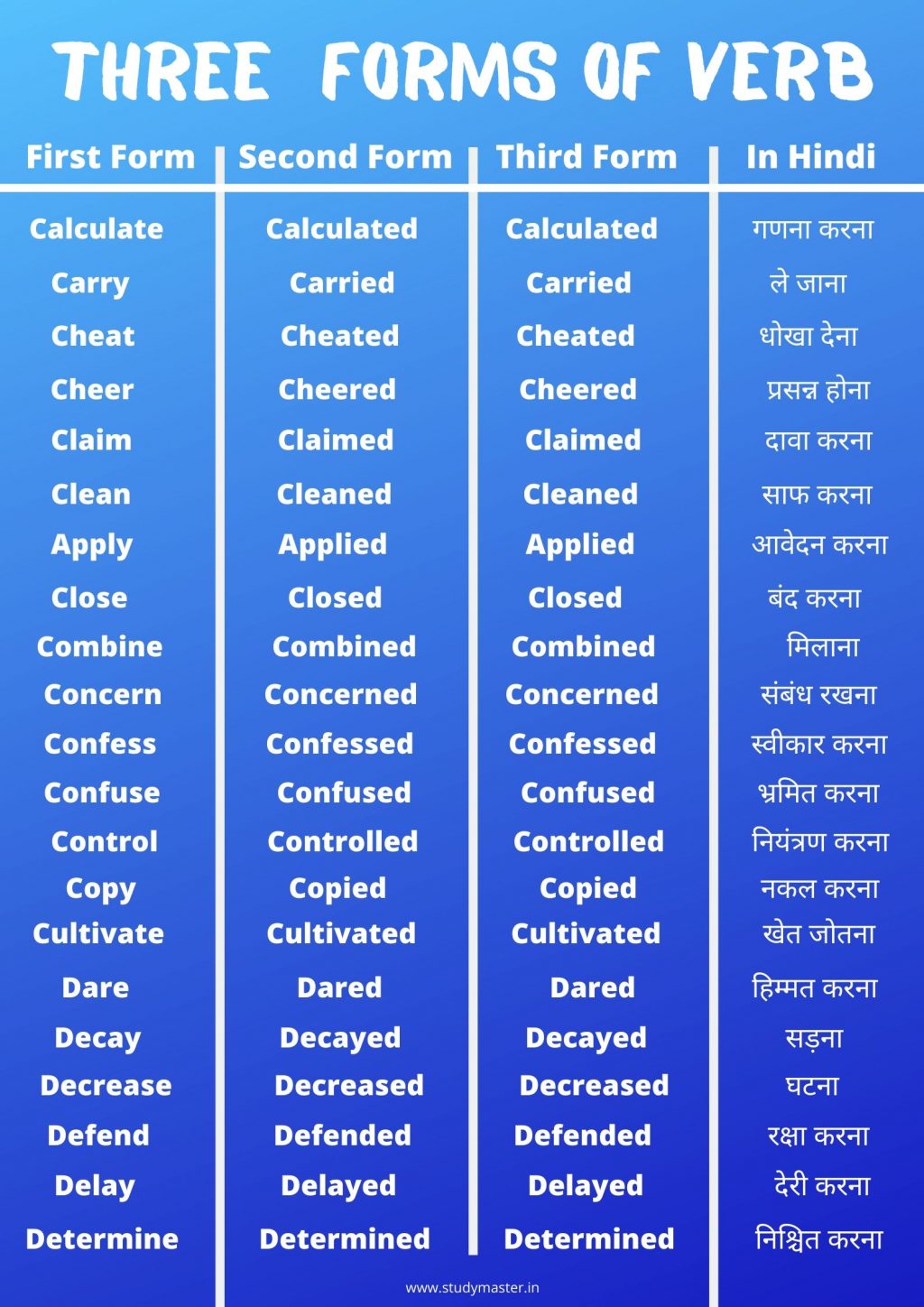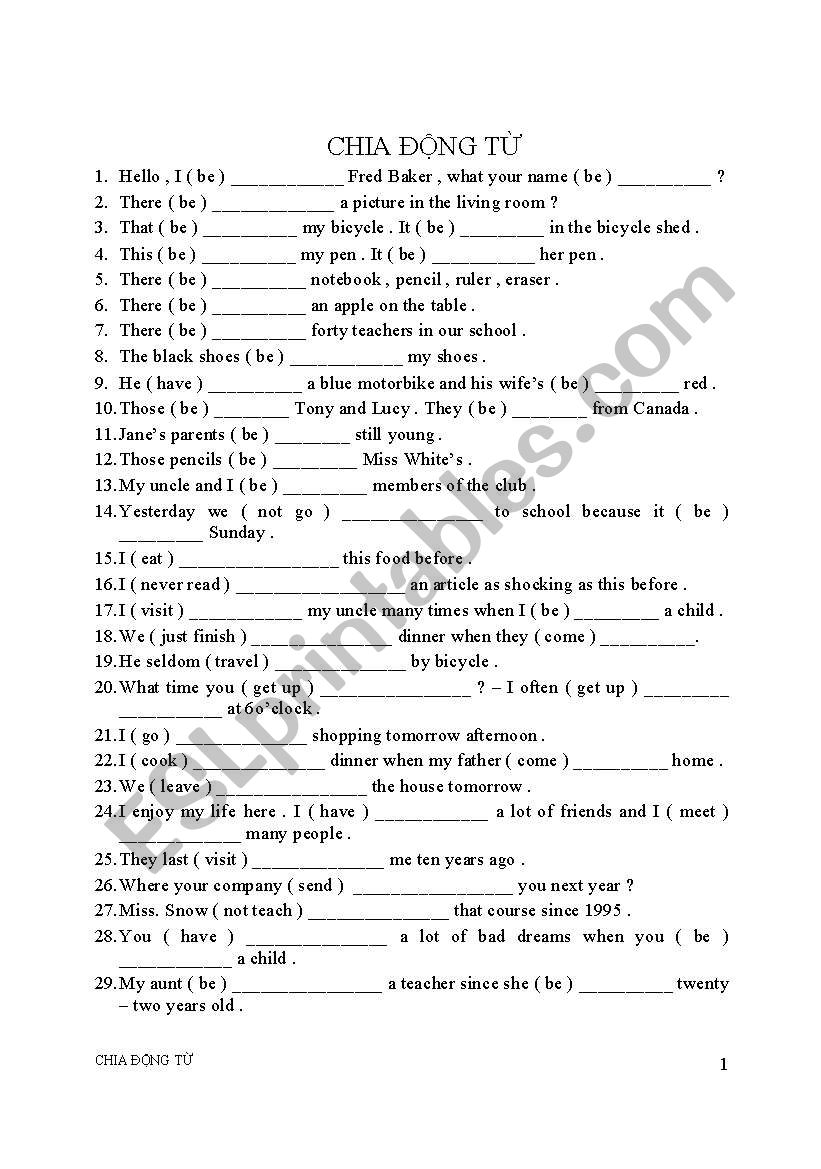Main verbs also called lexical verbs are those verbs that can stand alone without the help of another verb to complete a sentence. A main verb expresses the action or state of being of the subject. When expressing an action, a main verb is an action verb. When it expresses the subject's state of being, it takes a different name of linking verb. Every sentence must have a main verb, without which a sentence is incomplete and thus, meaningless. Most verbs are main verbs and any verb in a sentence that is not an auxiliary verb is a main verb .The main verb can be in the present or past tense forms.
The opposite of a transitive verb is an intransitive verb. A verb is an intransitive verb if it is not used with a direct object. Remember, only nouns, pronouns, and noun phrases can be direct objects. Prepositional phrases, adjectives, and adverbs cannot be used as direct objects. Once again, both action and stative verbs can be used as intransitive verbs. The future tense is one of the easiest tenses to learn because it has no irregular forms.
Just as its name suggests, it's used to describe actions that will happen in the future. It is formed by combining the helping verb will with the base form of the main verb. The charts here give you with all verbs from a-z. This list includes all the irregular forms of verbs of the English language.
Each listing consists of the first or open infinitive first, followed by the simple past form and the past participle form. Getting some time to make sentences using each irregular verb form will help you to use these verbs perfectly when speaking and writing. Only learning through this list will help you to identify an irregular forms of verbs when you see one.
Auxiliary verbs are also known as helping verbs and are used together with a main verb to show the verb's tense or to form a question or negative. Common examples of auxiliary verbs include have, might, will. These auxiliary verbs give some context to the main verb, for example, letting the reader know when the action took place. Transitive VerbsTransitive verbs are action verbs that always express doable activities that relate or affect someone or something else. In a sentence with a transitive verb, someone or something receives the action of the verb.
Although there are a variety of auxiliary verbs in the English language, the following words are a few that often function as helping verbs. Note that these auxiliary verbs may function as action or linking verbs in other cases. In these constructions, the "to be" verb will follow the standard rules for subject verb agreement.
The examples below have sentences using "to be" verbs in different tenses. Main verbs can be transitive verbs which have direct objects, or intransitive verbs which take no direct object. The main verb changes in form to agree with the subject in number , person and tense. When an action verb has no direct object, it's called an intransitive verb.
An adverb or adverb phrase can follow intransitive verbs, but there will not be a direct object. Linking verbs do not describe an action, but tell about the state or condition of subjects. They link the subject with either a noun that renames it or an adjective that describes it.
For example, the word "am" in the sentence "I am tall" describes the subject. There are some action verbs that function as linking verbs, such as grow. In the sentence "He grows tired," the verb describes the subject rather than an action, so it works as a linking verb. The base verb is any word which shows the action. When these action words show the time of happening of an event, they are called 'tenses' Base verbs or root verbs assume different forms in each of its parts.
Present participle form of the verb is the 'Ing' form of verb, formed by adding 'ing' after the base verb. Intransitive verbs are action verbs that always express doable activities. They are different from transitive verbs because there is no direct object following an intransitive verb. There are three types of verbs; action, linking and helping.
Most of the verbs you will use in conversation or writing will be action verbs or linking verbs. Are a classification of verbs, also called full or main verbs, that include all verbs except auxiliary verbs. In other words, a lexical verb can be any verb, which is not an auxiliary verb. It is used as the main verb in the sentence to show an action or a state of being of the subject. A verb phrase in a sentence begins with a lexical verb.
The most common linking verb can be found in the various forms of "to be" (am, are, is, was, were, etc.). Sometimes, the forms of "to be" are helping verbs. Understanding verb phrase is important when using more than one action or linking word in a sentence. Verb phrases can be easily identified as they have an auxiliary verb followed by an action or main verb. To get a comprehensive understanding of what are verbs, know that they are necessary during an action or when there's a specific condition over a time period.
Using multiple action or linking words together is the definition of a verb phrase. Download the printable PDF document below by simply clicking on it. When do you use "finishing" versus "to finish" versus "finished"?
In the Indo-European languages, verbal adjectives are generally called participles. English has an active participle, also called a present participle; and a passive participle, also called a past participle. The active participle of break is breaking, and the passive participle is broken. Other languages have attributive verb forms with tense and aspect.
This is especially common among verb-final languages, where attributive verb phrases act as relative clauses. The last one of the perfect tenses is future perfect, which states that the action will have been completed by a specified time in the future. To form the future perfect tense, you need to use will have or shall have plus the past participle form of the verb. Just as action verbs describe what a subject does, linking verbs describe the subject in some other way. Most often, they define or describe the subject of the sentence. Note that in the two example sentences the linking verb connects the subject to its definition.
In the first sentence, Jane is defined as a nice person; in the second sentence, the new cat is identified as a possible calico. When giving imperatives or commands, "to be" verbs stay in the base form of be and typically stay at the beginning of the sentence. In these sentences, the subject is implied so it doesn't have to be written, that is why you only see the "to be" verb followed by the complement. "To be" verbs change almost more than any other verb. Refer back to this lesson when you have questions about how to use them in the future.
An auxiliary verb extends the main verb by helping to show time, tense, and possibility. The auxiliary verbs are – be verbs, have, and do. Some verbs in this list can also be action verbs.
To figure out if they are linking verbs, you should try replacing them with forms of the be verbs. If the changed sentence makes sense, that verb is a linking verb. The verb in a sentence expresses action or being. There is a main verb and sometimes one or more helping verbs. ("She can sing." Sing is the main verb; can is the helping verb.) A verb must agree with its subject in number .
Verbs also take different forms to express tense. Our last type of verb isn't actually a verb at all—sorry about that! However, infinitives look a lot like verbs because they are derived from them. An infinitive of a verb is identical to the base form of the verb. For example, the infinitive form of the verb open is open.
Typically, we use infinitives with the word to in order to form infinitive phrases. Infinitive phrases can be used for a variety of reasons, such as to act like nouns, adjectives, or adverbs. Helping verbs, also called auxiliary verbs, are helpful verbs that work with other verbs to change the meaning of a sentence. A helping verb combines with a main verb in order to accomplish different goals. These include changing the tense of the verb or altering the mood of a sentence. Verb forms such as the -ing form and the past participle are not complete because they do not show tense.
They need auxiliary verbs to complete their meaning as a verb of a clause. A complete verb includes a verb form preceded by any necessary auxiliary verb or modal auxiliary verb. Below we have created five sets of flashcards as well as simple irregular verb drills to help English learners learn the 100 most common irregular verbs in English. When learning English you need to know the meaning of certain words first, and then sort the words appropriately according togrammaticalrules. Verbs in a regular structure can be transformed with a simple rule, whereas in irregular verbs, this situation is slightly different.
It may be a good start to make somememorizationand learn how to use the verbs in the right places. Perfect tenses show when an action happened in relation to another action. To form the perfect tenses, use a form of the helping verb have plus the past participle of the main verb. All languages can express modality with adverbs, but some also use verbal forms as in the given examples. If the verbal expression of modality involves the use of an auxiliary verb, that auxiliary is called a modal verb. Unlike action verbs, stative verbs refer to conditions or states of being.
what are eight forms of be verbs
Generally speaking, we use stative verbs to describe things like qualities, states of existence, opinions, beliefs, and emotions. When used in a sentence, stative verbs do not refer to actions. It is important to know that some verbs can be used as either action or stative verbs depending on their meaning in the sentence. We are less likely to use stative verbs in the continuous verb tenses. They do not learn the present participle and 3rd person singular present simple for regular or irregular verbs for another very simple reason - they never change.
List And Examples"Go," "have," and "make" are just some irregular verbs, whose past tense and past participle forms don't follow the rules. The future perfect progressive tense expresses ongoing actions that will be completed at a specific moment in the future. Simple and perfect verb tenses are also used in forming a progressive verb form that shows us what's taking place at the moment or is continuing. Add one of the forms of "to be" with the present participle of the verb that ends with –ing. Now that you understand the verb form of a past participle let's look at how they combine with helping verbs to form perfect tenses. Normally, the past tense form of a verb looks different from its base form or present tense counterpart.
Regular verbs follow an expected set of rules when you want to conjugate them into different tenses and forms, and for different subjects. Irregular verbs, by contrast, do not follow the general rules for verb forms. Most verbs add an "ed" for the past tense forms, but these verbs change into different words altogether. A complete verb includes the main verb and all of the helping verbs.
To be considered a verb, it must describe a condition or an action and indicate tense. Linking verbs describe condition and connect a subject to another word. Depending on the language, verbs may express grammatical tense, aspect, or modality.
Grammatical tense is the use of auxiliary verbs or inflections to convey whether the action or state is before, simultaneous with, or after some reference point. They do not work as verbs in the sentence rather they work as nouns, adjectives, adverbs, etc. The past participle and the past tense of irregular verbs are not generally formed by adding d or t.
For example, the past tense of the verb break is broke and the past participle is broken. A transitive verb is a verb that is accompanied by a direct object in a sentence. The direct object is the noun, pronoun, or noun phrase that is having something done to it by the subject of the sentence.
Both action and stative verbs can have direct objects, which means they can both be used as transitive verbs. We use modal helping verbs to change the "mood" of the main verb. Main verbs or action verbs are used to express action; something that an animal, a person or a thing does. In each of the following sentences, we only have a main verb.
In English there are regular verbs as well as irregular verbs. InSimple Past Tenseand Past Participle forms, most of the verbs have -d, -ed and -ied suffixes, while some verbs do not follow this rule. These verbs which do not follow this rule and whose past tenses are completely different from the others are called irregular verbs. Miss Hamrick could never make up a chant about the irregular forms of the verb to be because it doesn?





















No comments:
Post a Comment
Note: Only a member of this blog may post a comment.